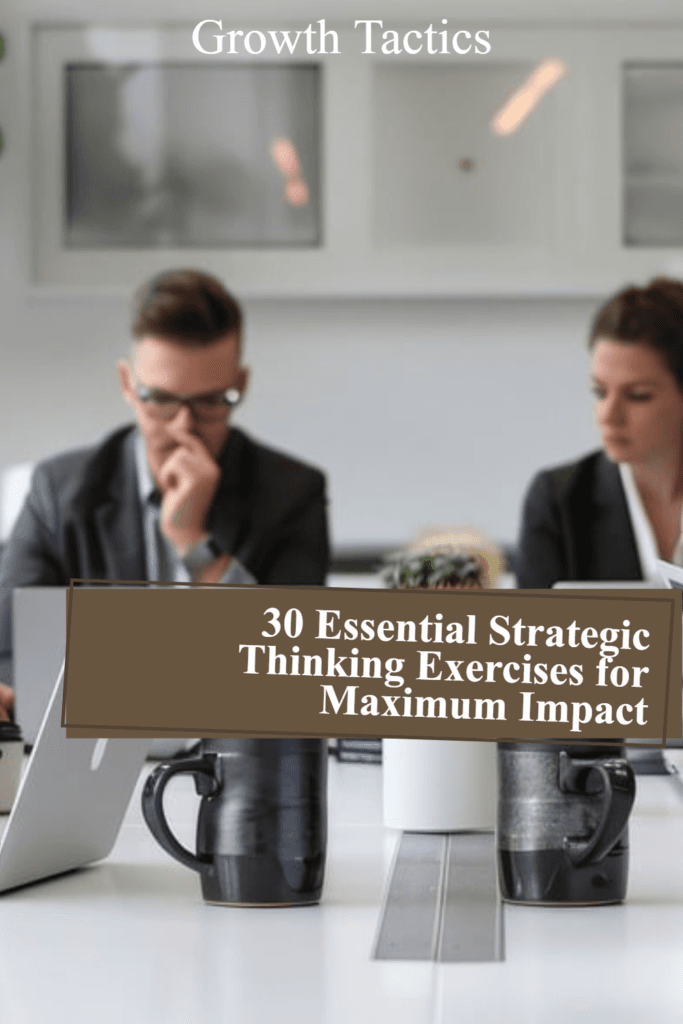Strategic thinking is a crucial skill for business leaders, managers, and employees in today’s fast-paced, competitive world. It involves generating long-term goals, anticipating trends, and making informed decisions to gain a competitive advantage. In this article, we will explore various strategic thinking exercises that can help you and your team think more strategically, strengthen your strategic thinking skills, and become a strategic thinker.
Jump To Section
The Importance of Strategic Thinking Exercises
Strategic thinking is essential for leadership, creativity, and achieving an organization’s goals and objectives. It allows business leaders to analyze their company’s position, envision new ideas, and develop a strategic plan to execute those ideas. By encouraging strategic thinking, managers can foster an environment where employees are continually seeking new ways to improve the organization and achieve positive outcomes.

Exercises to Enhance Strategic Thinking Skills
In this article section, we will explore 20 exercises specifically designed to enhance your strategic thinking skills. Strategic thinking techniques are essential for leaders to navigate complex challenges, make informed decisions, and drive organizational success.
These exercises will help you sharpen your strategic thinking abilities, expand your perspectives, and unleash your creativity. By engaging in these exercises, you will cultivate a strategic mindset and develop the skills necessary to tackle the ever-evolving business landscape. Get ready to strengthen your strategic thinking muscles as we dive into these 20 exercises!
1. Scenario Planning
Scenario planning is an exercise that encourages participants to envision various future scenarios for their organization. By brainstorming potential situations, team members can anticipate potential challenges, develop new ideas, and create actionable plans to tackle those challenges. This exercise helps to improve strategic thinking skills by allowing participants to analyze trends, evaluate the possible outcomes, and customize their approach based on the insights gained.
2. Brainzooming
Brainzooming is a team-building exercise that promotes strategic thinking by challenging participants to generate new ideas and solve problems creatively. In this exercise, team members are encouraged to think outside the box and explore new perspectives. By combining creativity with strategic thinking, participants can develop innovative solutions that deliver a competitive advantage.
3. SWOT Analysis
A SWOT analysis is a strategic planning tool that helps individuals and organizations identify their strengths, weaknesses, opportunities, and threats. This exercise allows participants to evaluate their current situation, anticipate future trends, and develop strategies to address potential challenges. By understanding their organization’s position, participants can make informed decisions and execute plans that align with their goals.
4. Objective Setting
Setting clear objectives is a critical step in strategic thinking. This exercise involves establishing specific, measurable, achievable, relevant, and time-bound (SMART) goals for your organization. By focusing on your goals and objectives, you can ensure that your strategic thinking efforts are aligned with your organization’s priorities and desired outcomes.
5. Competitive Analysis
Understanding your competitors is essential to strategic thinking. In this exercise, participants are encouraged to analyze their competitors’ strengths, weaknesses, opportunities, and threats. By evaluating the competitive landscape, team members can develop strategies to differentiate themselves from their competitors and gain a competitive advantage.
6. Trend Analysis
Trend analysis is an exercise that focuses on identifying emerging trends and understanding their potential impact on your organization. By staying informed about industry trends, participants can anticipate changes, adapt their strategies, and capitalize on new opportunities.
7. Communication Skills Development
Effective communication is vital for strategic thinking. In this exercise, participants are encouraged to practice their communication skills by presenting their ideas, engaging in discussions, and collaborating with others. By improving their communication skills, team members can better articulate their strategic vision and gain buy-in from others.
8. Mind Mapping
Mind mapping is a visual tool that helps individuals and teams organize their thoughts, ideas, and information. By creating a visual representation of your ideas, you can better understand the relationships between different concepts and identify new connections. This tool can be particularly useful for brainstorming, problem-solving, and strategic planning sessions.
9. PESTLE Analysis
PESTLE analysis is a strategic tool that examines the external factors affecting an organization. It stands for Political, Economic, Social, Technological, Legal, and Environmental factors. By assessing these factors, you can identify potential opportunities and threats in the external environment and develop strategies to address them. This analysis helps to broaden your perspective and consider various external influences on your organization.
10. Gap Analysis
Gap analysis is a tool that helps you identify the difference between your organization’s current state and its desired future state. By understanding the gaps in performance, resources, or capabilities, you can develop targeted strategies to bridge those gaps and achieve your goals. This tool can be useful for strategic planning, resource allocation, and performance improvement initiatives.
11. Game Theory
Game theory is a strategic tool that examines decision-making and interactions between different players in a competitive environment. By using game theory, you can understand the potential outcomes of various strategic decisions and develop optimal strategies based on the behavior of other players. This tool can be particularly helpful for understanding competitive dynamics and developing strategies to outperform your competitors.

12. Balanced Scorecard
The balanced scorecard is a strategic management tool that helps organizations track their performance across multiple dimensions, including financial, customer, internal processes, and learning and growth perspectives. By monitoring performance across these dimensions, you can ensure that your strategic initiatives are balanced and aligned with your organization’s overall objectives. This tool can be useful for performance measurement, strategic planning, and decision-making.
13. Porter’s Five Forces
Porter’s Five Forces is a strategic analysis tool that helps organizations understand the competitive forces within their industry. The five forces include the threat of new entrants, the bargaining power of suppliers, the bargaining power of buyers, the threat of substitute products or services, and the intensity of competitive rivalry. By analyzing these forces, you can develop strategies to enhance your competitive position and achieve long-term success.
14. Reverse Brainstorming
Reverse brainstorming is a creative problem-solving exercise that involves identifying potential problems instead of solutions. By focusing on potential issues, participants can gain a deeper understanding of the challenges they face and develop strategies to prevent or mitigate them. This exercise encourages strategic thinking by requiring participants to anticipate potential obstacles and develop proactive solutions.
15. The Six Thinking Hats
The Six Thinking Hats exercise, developed by Edward de Bono, is a technique that encourages participants to approach problems and decisions from different perspectives. The six hats represent different modes of thinking: white (facts and information), red (emotions and feelings), black (critical judgment), yellow (positive aspects), green (creativity and new ideas), and blue (process and organization). By switching between these different modes of thinking, participants can develop a more comprehensive understanding of the situation and develop well-rounded strategies.
16. Role Playing
Role-playing exercises require participants to assume different roles within a hypothetical scenario. By stepping into the shoes of others, participants can gain a better understanding of different perspectives, anticipate potential reactions, and develop strategies that consider the needs and motivations of various stakeholders. This exercise enhances strategic thinking skills by encouraging empathy and a broader understanding of the situation.
17. The Five Whys
The Five Whys exercise is a technique used to identify the root cause of a problem by asking “why” five times. By continually asking why a problem exists, participants can uncover the underlying issues and develop targeted strategies to address them. This exercise encourages strategic thinking by requiring participants to analyze problems deeply and develop long-term solutions.
18. Pre-Mortem Analysis
A pre-mortem analysis is an exercise that involves imagining that a project or initiative has failed and then identifying the reasons for the failure. By anticipating potential pitfalls and challenges, participants can develop strategies to prevent or mitigate those issues before they occur. This exercise promotes strategic thinking by encouraging participants to think critically about potential risks and develop proactive solutions.
19. Blue Ocean Strategy
The Blue Ocean Strategy exercise encourages participants to identify untapped market spaces and create new demand by developing innovative products or services. By focusing on differentiation and low cost, participants can create a competitive advantage and achieve long-term success. This exercise enhances strategic thinking skills by encouraging innovation and the exploration of new opportunities.
20. The Four Quadrant Matrix
The Four Quadrant Matrix is a strategic decision-making tool that helps participants prioritize tasks or initiatives based on their importance and urgency. By categorizing tasks into four quadrants (urgent and important, important but not urgent, urgent but not important, and neither urgent nor important), participants can allocate their resources and time more effectively. This exercise encourages strategic thinking by requiring participants to evaluate priorities and make informed decisions.
21. Backcasting
Backcasting is a planning method that starts with defining a desirable future and then works backward to identify the steps necessary to achieve that future. This exercise encourages participants to think strategically by envisioning long-term goals and planning concrete steps to reach those goals.
22. Force Field Analysis
Force Field Analysis is a decision-making tool that helps identify and analyze the forces driving or hindering change within an organization. By understanding these forces, participants can develop strategies to strengthen the driving forces and weaken the restraining forces, leading to more effective change management.
23. Strategic Group Mapping
Strategic Group Mapping involves plotting organizations within an industry based on various strategic dimensions (e.g., quality vs. cost). This exercise helps participants identify their organization’s strategic position relative to competitors and uncover opportunities for differentiation and strategic moves.
24. Stakeholder Analysis
Stakeholder Analysis involves identifying and assessing the interests and influence of various stakeholders involved in a project or decision. By understanding stakeholders’ motivations and concerns, participants can develop strategies to address their needs and align stakeholder interests with organizational goals.
25. Delphi Method
The Delphi Method is a forecasting technique that involves gathering insights and opinions from a panel of experts through multiple rounds of questionnaires. By synthesizing expert opinions, participants can develop informed strategic decisions and anticipate future trends and challenges.
26. Value Chain Analysis
Value Chain Analysis involves mapping out all the activities involved in producing a product or service and identifying opportunities for optimization. By understanding where value is created and identifying inefficiencies, participants can develop strategies to enhance competitive advantage and improve organizational performance.
27. Fishbone Diagram
A Fishbone Diagram, also known as a Cause-and-Effect Diagram, is a tool used to identify the root causes of a problem by categorizing potential causes into various categories. This exercise helps participants analyze complex problems, uncover underlying issues, and develop comprehensive strategies to address them.
28. Benchmarking
Benchmarking involves comparing your organization’s processes, performance metrics, and practices against best-in-class organizations. By identifying gaps and areas for improvement, participants can develop strategies to improve operations and achieve competitive parity or advantage.
29. Scenario Analysis
Scenario Analysis extends beyond Scenario Planning by not only envisioning future scenarios but also developing detailed action plans for each scenario. This exercise enhances strategic thinking by preparing participants for a range of possible futures and ensuring readiness for various contingencies.
30. Strategic Alignment Grid
The Strategic Alignment Grid is a tool used to ensure that an organization’s strategic initiatives are aligned with its overall goals and objectives. By mapping initiatives against strategic goals, participants can identify misalignments and develop strategies to ensure all efforts are directed toward achieving the organization’s mission.
Encouraging Strategic Thinking in Your Organization
To encourage strategic thinking within your organization, consider implementing workshops, team-building exercises, and brain training activities that focus on strategic thinking skills. Providing employees with the tools and resources to think strategically can lead to increased innovation, improved decision-making, and a more successful organization.
In conclusion, strategic thinking exercises are essential for developing the skills necessary to become a strategic thinker. By practicing these exercises regularly, individuals and teams can improve their ability to anticipate trends, evaluate potential challenges, and develop innovative solutions to achieve their goals. Take the time to invest in your strategic thinking skills and watch your organization thrive in today’s competitive landscape.
Did you enjoy this article on strategic thinking exercises? Please share and subscribe.


